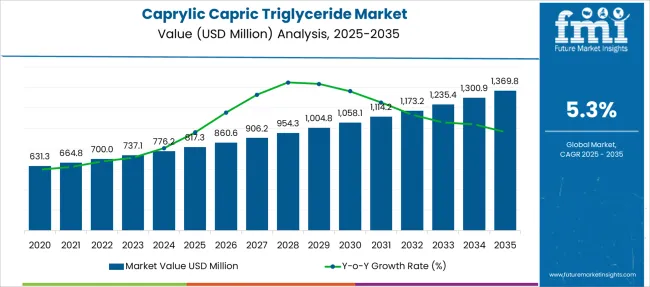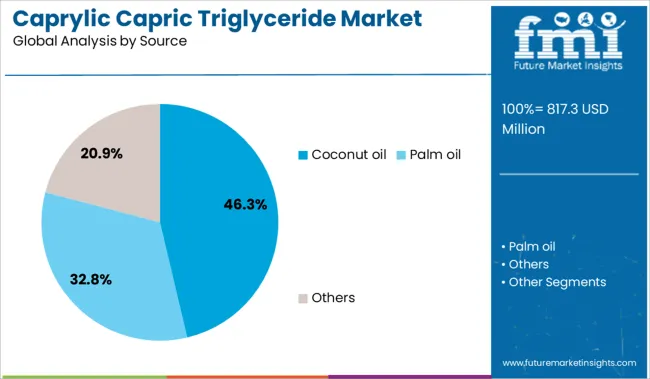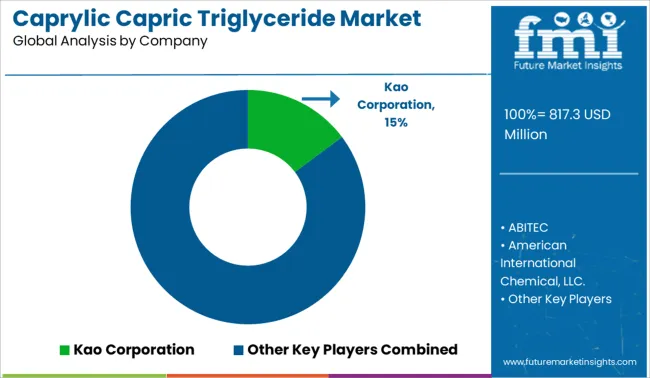The Caprylic Capric Triglyceride Market is estimated to be valued at USD 817.3 million in 2025 and is projected to reach USD 1369.8 million by 2035, registering a compound annual growth rate (CAGR) of 5.3% over the forecast period.

| Metric | Value |
|---|---|
| Caprylic Capric Triglyceride Market Estimated Value in (2025 E) | USD 817.3 million |
| Caprylic Capric Triglyceride Market Forecast Value in (2035 F) | USD 1369.8 million |
| Forecast CAGR (2025 to 2035) | 5.3% |
The caprylic capric triglyceride market is experiencing notable growth, primarily driven by its widespread use in cosmetic and personal care formulations. As a stable, non-greasy emollient derived from natural sources, it has gained popularity among manufacturers seeking clean-label, skin-friendly alternatives to synthetic oils. Its multifunctionality in delivering moisturization, improving texture, and enhancing the shelf life of formulations has positioned it as a key ingredient in skincare, haircare, and pharmaceutical emulsions.
Growing consumer awareness regarding the safety and environmental impact of cosmetic ingredients is fostering a shift toward bio-based raw materials, further propelling adoption. Additionally, increased investment in sustainable sourcing and green chemistry practices has amplified the availability of caprylic capric triglyceride derived from renewable resources.
Regulatory approvals for topical applications and its compatibility with sensitive skin products have supported its inclusion in dermatologically tested and hypoallergenic formulations In the coming years, demand is expected to rise steadily across both premium and mass-market personal care brands, particularly as product transparency and ingredient efficacy continue to shape consumer preferences.
The market is segmented by Form, Source, Application, and End Use and region. By Form, the market is divided into Liquid and Semi-solid. In terms of Source, the market is classified into Coconut oil, Palm oil, and Others. Based on Application, the market is segmented into Skin Care, Hair Care, Makeup, Fragrances, Bath and Body Care, Food, and Medicines. By End Use, the market is divided into Cosmetic and Personal Care Industry, Pharmaceutical Industry, Food and Beverage Industry, Health and Wellness Industry, and Others. Regionally, the market is classified into North America, Latin America, Western Europe, Eastern Europe, Balkan & Baltic Countries, Russia & Belarus, Central Asia, East Asia, South Asia & Pacific, and the Middle East & Africa.

The liquid form segment is expected to account for 52.9% of the total revenue share in the caprylic capric triglyceride market in 2025, positioning it as the dominant form used across various industries. The preference for the liquid form has been driven by its high compatibility with oil-based formulations and its ease of blending with other cosmetic ingredients. The stability and clarity of liquid caprylic capric triglyceride make it ideal for emulsions, serums, and lotions, where uniform texture and fast absorption are essential.
Its low viscosity and odorless profile enable its integration into both aqueous and anhydrous systems without altering the final product’s sensory experience. Additionally, manufacturers benefit from reduced processing complexity and improved solubility, which supports large-scale production.
The liquid form has also shown strong demand in pharmaceutical and nutraceutical formulations due to its consistent bioavailability and smooth application properties These combined attributes continue to reinforce the liquid form’s leading position in the global market.

The coconut oil source segment is projected to contribute 46.3% of the overall revenue in the caprylic capric triglyceride market by 2025, driven by its natural origin and superior fatty acid composition. Coconut oil has been favored as a sustainable and renewable raw material offering a consistent yield of caprylic and capric acids necessary for triglyceride synthesis. Its widespread availability and cost-effective extraction process have enabled high-volume production without compromising quality standards.
The perception of coconut oil as a safe and non-irritating ingredient has encouraged its use in formulations for sensitive skin, baby care, and therapeutic applications. Additionally, its alignment with organic and clean beauty trends has made it the preferred choice among manufacturers and consumers seeking ethically sourced ingredients.
Enhanced traceability and certification mechanisms in coconut farming have further strengthened its reputation as a responsible and eco-friendly feedstock As global demand for plant-based cosmetic ingredients continues to rise, the coconut oil segment is expected to maintain its strong foothold in the supply chain.

The skin care segment is anticipated to hold 27.7% of the revenue share in the caprylic capric triglyceride market by 2025, reflecting its central role in the product’s end-use applications. The widespread use of caprylic capric triglyceride in moisturizers, creams, and anti-aging products has been supported by its non-comedogenic properties and excellent skin compatibility.
Its ability to create a silky, non-greasy finish while delivering long-lasting hydration has made it a key component in both luxury and everyday skincare lines. The ingredient’s function as a dispersing agent for active ingredients and its resistance to oxidation have enabled improved product performance and stability.
Regulatory acceptance for topical use and rising consumer interest in minimalist, functional ingredients have further promoted its usage With ongoing innovation in skin care formulations and the growing demand for gentle yet effective moisturizers and serums, caprylic capric triglyceride is expected to remain a core emollient in future skin care developments.
Caprylic capric triglyceride is gaining huge popularity across the personal care and cosmetics industries, on account of its favorable properties such as skin replenishment, emollient, antioxidant, moisturizing, and non-greasy feel among others.
It is extensively being used in various personal care and cosmetics products such as face creams, perfumes, moisturizers, lipstick, foundations, eye makeup, sunscreens, and others.
Hence, accelerating sales of the aforementioned products, owing to the growing consumer spending on enhancing body and facial aesthetics across the world is projected to create high revenue generation opportunities for the caprylic capric triglyceride market.
There are some side effects associated with the use and consumption of caprylic capric triglycerides such as skin irritation, the development of rashes, gastric distress, nausea, and diarrhea among others. A growing instance of such ailments is impeding sales in the global market.
The high cost of caprylic capric triglyceride and the increasing availability of low-cost substitutes are some of the factors restraining the growth in the market.
As per Future Market Insights, South Asia is estimated to emerge as a highly remunerative market for caprylic capric triglyceride between 2025 and 2035.
Over the last few years, a significant rise in the number of baby births is being witnessed across South Asia, creating strong demand for baby care products. For instance, according to United Nations International Children's Emergency Fund (UNICEF), nearly 67,385 babies are born across India every day.
Due to its high moisturizing, skin nourishing, and antioxidant properties, caprylic capric triglyceride is increasingly used for the production of baby care products such as soaps, massage oil, body lotions, and others. Hence, rising baby births are projected to bolster sales in the South Asia market.

North America is anticipated to exhibit growth at a rapid CAGR in the global caprylic capric triglyceride market during the forecast period 2025 to 2035, states FMI.
As the trend of adopting clean-label products and inclination toward plant-based & organic personal care & cosmetics products continues to grow across North America, there is a rapid surge in demand for natural sources of essential ingredients such as caprylic capric triglyceride.
On account of the approval by the Food and Drug Administration regarding the use of caprylic capric triglyceride, leading players in the market are emphasizing expanding their production capacity to capitalize on surging demand. This is expected to drive growth in the North American market.

Some of the leading players in the caprylic capric triglyceride market are Kao Corporation, ABITEC, American International Chemical, LLC., Alzo International, Charkit Chemical, Vigon International, Jarchem Industries, Lonza Group, Lipo Chemicals, Penta International, and others.
The market for caprylic capric triglyceride is highly competitive, attributed to the adoption of strategies such as production capacity expansion, collaboration, merger, and acquisition by key companies.
| Report Attribute | Details |
|---|---|
| Growth Rate | CAGR of 5.3% from 2025 to 2035 |
| Base Year for Estimation | 2024 |
| Historical Data | 2020 to 2024 |
| Forecast Period | 2025 to 2035 |
| Quantitative Units | Revenue in USD Million, Volume in Kilotons, and CAGR from 2025 to 2035 |
| Report Coverage | Revenue Forecast, Volume Forecast, Company Ranking, Competitive Landscape, Growth Factors, Trends, and Pricing Analysis |
| Segments Covered | Form, Source, Application, End Use, Region |
| Countries Covered | North America; Latin America; Europe; East Asia; South Asia; Oceania; Middle East and Africa |
| Key Companies Profiled | Kao Corporation; ABITEC; American International Chemical, LLC.; Alzo International; Charkit Chemical; Vigon International; Jarchem Industries; Lonza Group; Lipo Chemicals; Penta International; Others |
| Customization | Available Upon Request |
The global caprylic capric triglyceride market is estimated to be valued at USD 817.3 million in 2025.
The market size for the caprylic capric triglyceride market is projected to reach USD 1,369.8 million by 2035.
The caprylic capric triglyceride market is expected to grow at a 5.3% CAGR between 2025 and 2035.
The key product types in caprylic capric triglyceride market are liquid and semi-solid.
In terms of source, coconut oil segment to command 46.3% share in the caprylic capric triglyceride market in 2025.






Our Research Products

The "Full Research Suite" delivers actionable market intel, deep dives on markets or technologies, so clients act faster, cut risk, and unlock growth.

The Leaderboard benchmarks and ranks top vendors, classifying them as Established Leaders, Leading Challengers, or Disruptors & Challengers.

Locates where complements amplify value and substitutes erode it, forecasting net impact by horizon

We deliver granular, decision-grade intel: market sizing, 5-year forecasts, pricing, adoption, usage, revenue, and operational KPIs—plus competitor tracking, regulation, and value chains—across 60 countries broadly.

Spot the shifts before they hit your P&L. We track inflection points, adoption curves, pricing moves, and ecosystem plays to show where demand is heading, why it is changing, and what to do next across high-growth markets and disruptive tech

Real-time reads of user behavior. We track shifting priorities, perceptions of today’s and next-gen services, and provider experience, then pace how fast tech moves from trial to adoption, blending buyer, consumer, and channel inputs with social signals (#WhySwitch, #UX).

Partner with our analyst team to build a custom report designed around your business priorities. From analysing market trends to assessing competitors or crafting bespoke datasets, we tailor insights to your needs.
Supplier Intelligence
Discovery & Profiling
Capacity & Footprint
Performance & Risk
Compliance & Governance
Commercial Readiness
Who Supplies Whom
Scorecards & Shortlists
Playbooks & Docs
Category Intelligence
Definition & Scope
Demand & Use Cases
Cost Drivers
Market Structure
Supply Chain Map
Trade & Policy
Operating Norms
Deliverables
Buyer Intelligence
Account Basics
Spend & Scope
Procurement Model
Vendor Requirements
Terms & Policies
Entry Strategy
Pain Points & Triggers
Outputs
Pricing Analysis
Benchmarks
Trends
Should-Cost
Indexation
Landed Cost
Commercial Terms
Deliverables
Brand Analysis
Positioning & Value Prop
Share & Presence
Customer Evidence
Go-to-Market
Digital & Reputation
Compliance & Trust
KPIs & Gaps
Outputs
Full Research Suite comprises of:
Market outlook & trends analysis
Interviews & case studies
Strategic recommendations
Vendor profiles & capabilities analysis
5-year forecasts
8 regions and 60+ country-level data splits
Market segment data splits
12 months of continuous data updates
DELIVERED AS:
PDF EXCEL ONLINE
Severe Hypertriglyceridemia (SHTG) Treatment Market Trends, Analysis & Forecast by Drug Class, Drug Delivery Method, Distribution Channel, Region through 2035
Medium-Chain Triglycerides Market Growth -Functional Fats & Industry Demand 2025 to 2035

Thank you!
You will receive an email from our Business Development Manager. Please be sure to check your SPAM/JUNK folder too.
Chat With
MaRIA